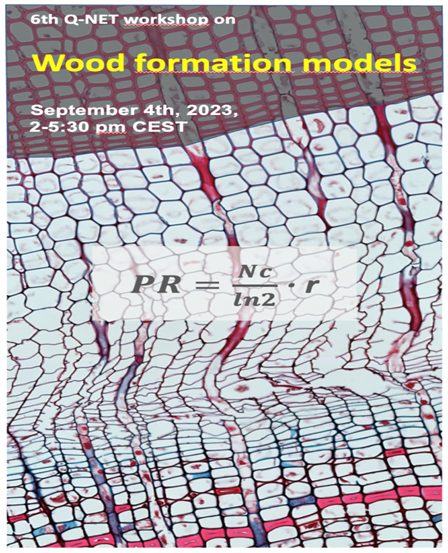
The Hans Merensky Chair in Measuring and Modelling Eucalypt Growth & Wood Formation
Understanding growth in the world's most widely planted hardwoods
Attending the 6th Q-NET workshop
Post authored by Dr Letitia Schoeman
EucXylo members recently attended the sixth virtual workshop hosted by Q-NET – a rapidly-growing network aimed at providing better understanding of Quantitative Wood Anatomy (QWA) in various contexts.
EucXylo is a frequent participant in the network using Quantitative Wood Anatomy called Q-NET. A key activity of Q-NET is free virtual workshops, which acts as “idea markets” profiting from an interdisciplinary network for developing and elaborating new collaborative ideas, defining standards, advancing methodology and creating synergies from a larger and more diverse network. On the 4th of September, Q-NET organised their 6th workshop titled: Wood Formation Models. This theme fell well into the research focus of EucXylo.
 The workshop started off with an initial presentation by the Q-NET Coordination Team founding member, Dr Georg von Arx, who presented the winner of the new Q-NET logo. Thereafter, Dr Annemarie Eckes-Shephard provided an introduction to wood formation models. This set the tone for six different sessions highlighting various wood formation models.
The workshop started off with an initial presentation by the Q-NET Coordination Team founding member, Dr Georg von Arx, who presented the winner of the new Q-NET logo. Thereafter, Dr Annemarie Eckes-Shephard provided an introduction to wood formation models. This set the tone for six different sessions highlighting various wood formation models.
Cyrille Rathgeber presented work on CAVIAR: an R package for checking, displaying, and processing wood-formation-monitoring data. Vladimir Shishov and Valentina Butto presented their Vaganov-Shashkin (VS) simulation model, which aims to go beyond previous statistical frameworks in providing a mechanistic tool for addressing questions such as details of climatic controls on the formation of conifer tree rings in dry, cold, and temperate regions. The work of Prof Dave Drew in pioneering xylogenesis modelling in hardwoods was also presented. More information on this model of xylem development and wood formation in pine can be obtained here: https://doi.org/10.1007/s00468-015-1216-1. This paper also explores a novel approach with regards to cell wall thickening, which besides carbon availability is dependent on the dynamically changing cell lumen surface area. Andrew Friend described how the current understanding of wood formation can be used to reformulate global vegetation models, with potentially major implications for their behaviour. He presented the RINGS model which can investigate mechanisms for the observed sensitivity of cell-mass density to temperature and the effect of changing zone widths. Felix Hartmann used the XyDyS2 model to simulate the development of a radial cell file over a growing season and to assess the model’s predictions against published experimental or observational data. Lastly, Annemarie Eckes-Shephard showcased the Deleuze & Houllier model, which is a simple process-based xylem growth model for describing wood microdensitometric profiles.
Wood formation models can be used to bridge the gap between xylogenesis and wood anatomy data. These datasets are also crucial to test the countless hypotheses which wood formation models incorporate in research fields such as forestry, dendroclimatology, and basic research. The workshop aimed to make wood formation models more accessible to xylogenesis and wood anatomy scientists.
This was a highly interactive workshop using menti-meter (a survey app), where members could participate in surveys during the workshop, about the data types you produce and what you need from a wood formation model for it to be useful to you.
Recordings of workshops are available to registered members (become a member here: Membership – Q-NET (qwa-net.com)) and registration is free. Here is the recording of the 6th workshop: 6th Q-NET Workshop – September 4, 2023 – YouTube.
Congratulations to Dr Georg von Arx and the other members of the Q-NET coordination team for a well-organized and interesting event, and for initiating such a valuable community platform!